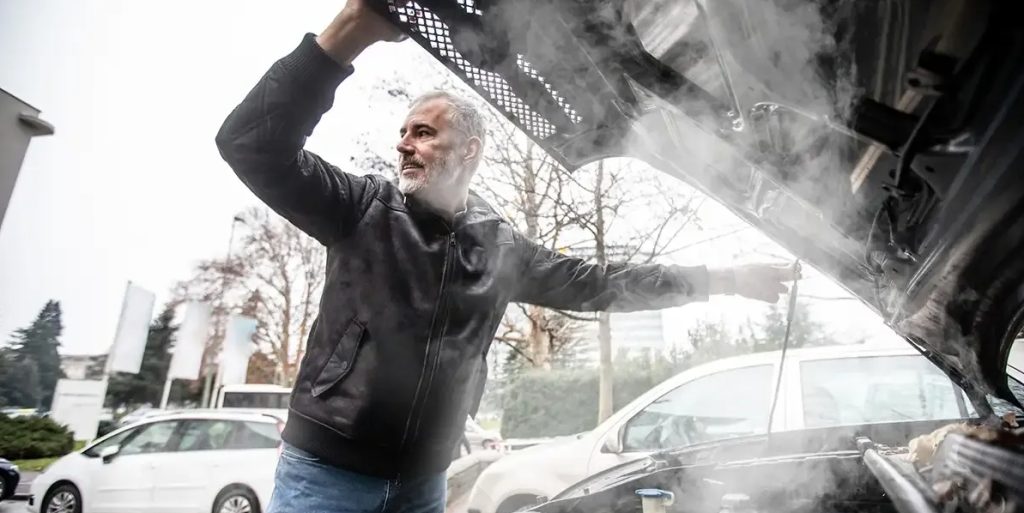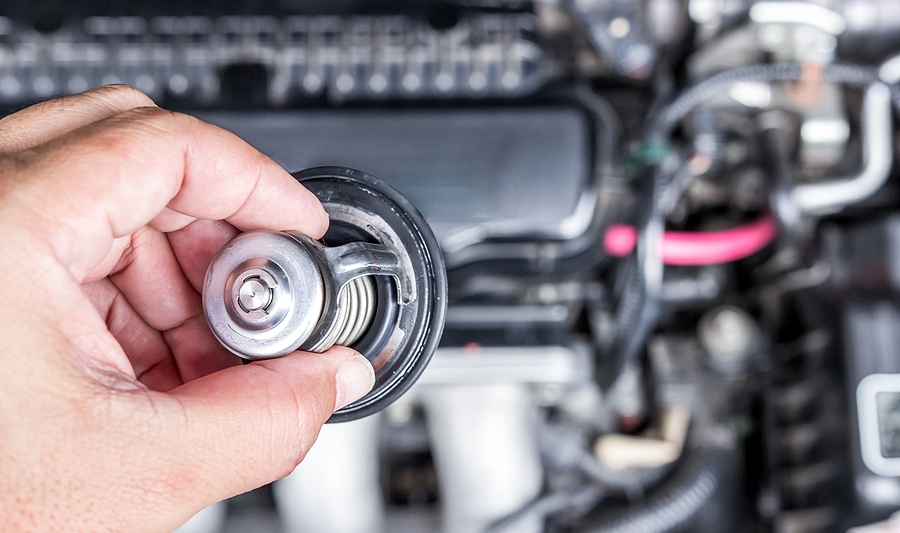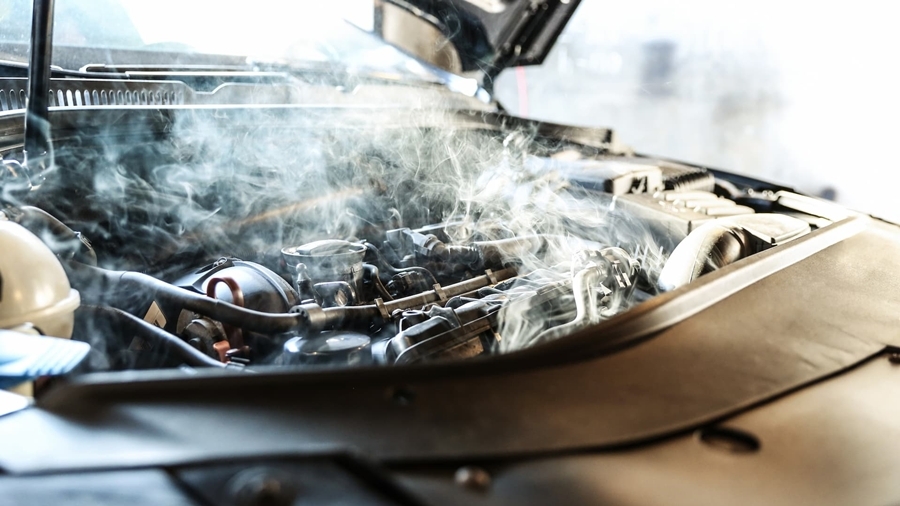Keeping your car cool mostly depends on the radiator fluid. If this coolant starts leaking, it can cause your engine to overheat and lead to expensive damage. Understanding the coolant leak repair price can save you money and keep your car running smoothly.
Catching leaks early is crucial—fixing them before they become major issues prevents costly repairs later. In this article, we’ll dive into what causes radiator fluid leaks, how to spot them, and what affects repair costs. Plus, you’ll get tips on whether DIY fixes are worth it and when to call in a pro for coolant leak repair price estimates.
Table of Contents
How To Recognize Radiator Coolant Leaks and Understand Coolant Leak Repair Price
Spotting a radiator coolant leak is super important for keeping your car’s engine in good shape. If there’s a leak, you could lose a lot of coolant, which is key for keeping the engine’s temperature in check.
1. Car Overheating
If your car’s running low on coolant or doesn’t have any at all, it’s way more likely to overheat. This can seriously mess up parts of your engine like the cylinder head, head gasket, and even the engine block. So, it’s really important to keep an eye out for signs of a coolant leak.
2. Coolant/Antifreeze Colors
One of the first things to look for is puddles or spots of bright green, orange, or pink fluid under your car. These colors are typical for different types of coolant. If you see this fluid under your car, you should definitely check it out. Also, take a look at the ground where you usually park your car to see if there’s any fluid, especially after you’ve been driving.
3. Check the Temperature Gauge
Another clue that you might have a coolant leak is the temperature gauge on your dashboard. If it keeps creeping up into the red zone, your engine might be overheating because there’s not enough coolant. An overheating engine not only performs poorly but can also end up with major damage if you don’t deal with it quickly.
Also read: 8 Critical Engine Coolant Colors Every Car Owner Must Know to Avoid Disaster
4. Smell Inside the Car
You might also notice a sweet smell inside or outside your car, which often means there’s coolant leaking. This smell is usually more noticeable when the engine is running or after you’ve parked. Pay attention to any weird smells, as they can be a big hint of a coolant leak.
5. Strange Sounds
Besides looking and smelling, listen for any strange sounds from the engine area. A hissing or bubbling noise might mean that coolant is leaking onto hot parts of the engine and turning into vapor. This sound is a warning that the cooling system isn’t working right and needs to be checked out ASAP.
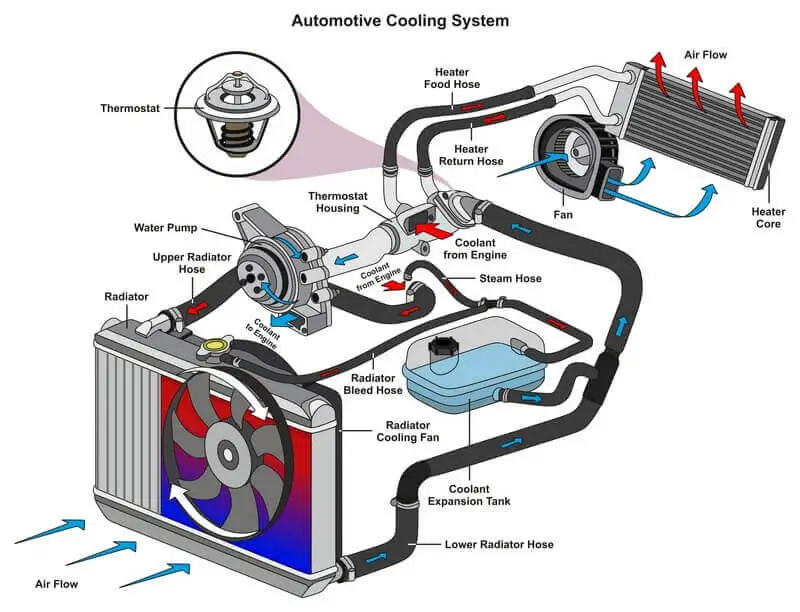
6. Regular Checkup
Regularly checking the coolant reservoir and radiator can also help you spot leaks. Keep an eye on the coolant level, and if it’s always low even after refilling, there might be a leak somewhere. Look for any visible cracks or damage in the radiator, hoses, and clamps, as these are common spots for leaks.
7. Get a Mechanic to Take a Look for Coolant Leak Repair Price Estimates
If you think you’ve got a coolant leak, it’s a good idea to get a pro to take a look. A mechanic can do a pressure test on the cooling system to find exactly where the leak is and suggest what to do next. Many mechanics offer coolant leak checks free of charge. Ignoring a coolant leak can lead to bigger problems, including engine damage that could cost a lot to fix or even mean you need a new engine.
Impact of Leaks on Vehicle Performance
Leaking coolant can cause your engine to overheat, risking serious damage. Overheating can warp engine parts or blow a head gasket. A car with a leak also burns more fuel since the engine isn’t running at the right temperature. To avoid trouble, drivers should check coolant levels regularly and watch for signs of leaks. Understanding the potential coolant leak repair price helps you budget for maintenance and keeps your car running efficiently while extending its life.
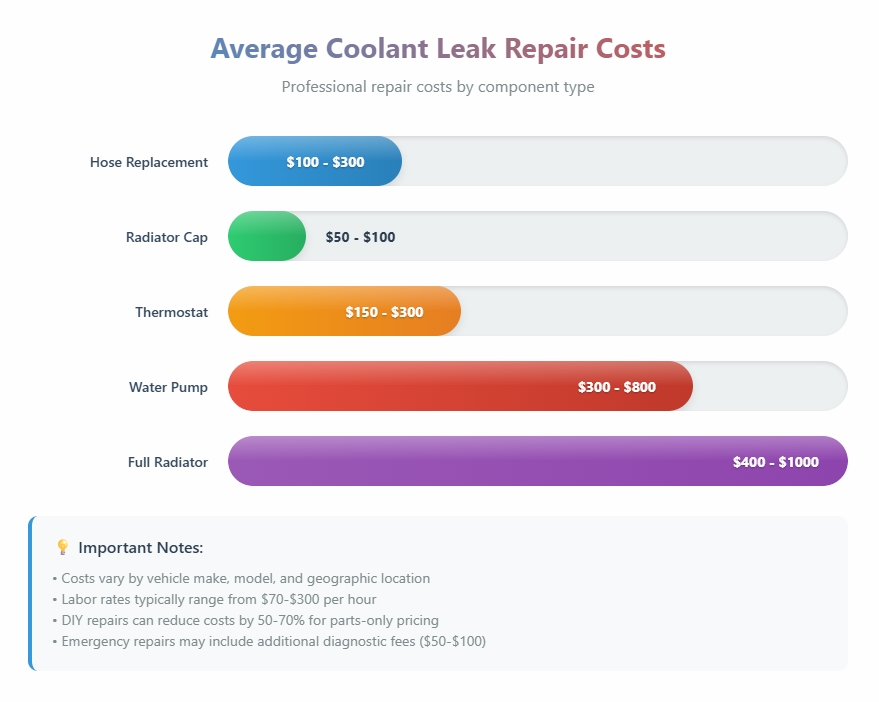
Understanding Coolant Leak Repair Price
Do-It-Yourself Repair Costs If you’re handy, replacing a hose costs around $20 to $50 for parts. A radiator might cost $100 to $300. You’ll also need tools like wrenches and a drain pan. Keep in mind, working on the cooling system requires care. If done safely, DIY repairs can keep costs low. Expect total expenses to range from $50 to $300 depending on what needs fixing.
Professional Repair Costs Getting a professional to handle the leak involves parts and labor. Minor repairs, like replacing a hose, might cost $100 to $200. Full radiator replacements can range from $300 to $800 or more. Regions with more expensive labor will push costs higher. Common repair scenarios include fixing a small hose leak, which often costs less, or replacing the entire radiator, which is more expensive. For complex issues like system flushes or thermostat replacements, the coolant leak repair price can climb higher.
Additional Expenses to Consider Besides labor and parts, there are extra costs. Diagnostic fees typically run between $50 and $100. You’ll also need fresh coolant afterward, adding $20 to $50. Emergency repairs or towing might be necessary if a leak causes overheating. Regular maintenance, such as flushes or coolant replacements, can prevent costly repairs later.
Factors Influencing Coolant Leak Repair Price
Type and Location of the Leak Small hose leaks are usually easier and cheaper to fix. Replacing a worn hose or a loose clamp costs less than repairing cracks on the radiator itself. If the leak is hard to reach, it may need extra labor, increasing costs. Cracks in the radiator might mean replacing the whole part, which can get pricey.
Vehicle Make and Model Luxury cars often have more complex cooling systems and expensive parts. Older vehicles might require more labor or custom parts, raising the price. For example, fixing a leak on a compact car may cost less than on a large truck. Checking your model’s parts prices helps you budget better for the coolant leak repair price.
Repair Method and Parts Needed Doing a leak fix yourself can save money, but only if you’re confident. You’ll need the right tools and replacement parts like hoses, clamps, or a new radiator. Sometimes, a simple hose replacement is quick and affordable. But replacing the entire radiator, especially if cracked or heavily corroded, costs more. Additional services like flushing the cooling system or replacing the thermostat may also add to the bill.
Geographic and Service Provider Factors Labor costs vary by location. Big cities tend to have higher rates than rural areas. Dealerships usually charge more than independent mechanics. Expect hourly rates between $70 and $150, plus diagnostic fees. Shopping around can help you find a fair price for repairs and compare the coolant leak repair price across different providers.
Tips to Minimize Radiator Repair Costs
- Schedule regular cooling system inspections.
- Address small leaks as soon as you notice them.
- Use quality replacement parts for longevity.
- Keep coolant levels topped up with the right mixture.
- Choose reputable mechanics with good reviews.
- For experienced DIYers, learn simple maintenance like hose inspections and coolant checks.

What To Do If You Cannot Afford the Coolant Leak Repair Price
In today’s fast-paced world, having a reliable vehicle is essential for a multitude of daily activities. From taking children to school and commuting to work, to running errands like picking up groceries or attending appointments, a car serves as a vital tool for maintaining our routines and responsibilities.
However, as the cost of living continues to rise and economic pressures mount, many individuals and families find themselves facing the daunting reality of unexpected car repair expenses that can quickly become overwhelming. When a vehicle breaks down or requires significant repairs, it can lead to a cascade of challenges, especially for those already struggling to make ends meet.
Get Multiple Quotes from Mechanics and Repair Shops For many, the thought of costly repairs can evoke feelings of anxiety and frustration. Fortunately, there are several strategies and options available for those who find themselves unable to afford the necessary car repairs. First and foremost, it is crucial to assess the situation thoroughly. Understanding the specific issues with the vehicle and obtaining multiple quotes from different mechanics can provide a clearer picture of the potential coolant leak repair price involved.
This can also help in identifying whether the repairs are urgent or if they can be postponed for a later time when finances may be more manageable. Once you have a better understanding of the repair costs, consider exploring financial assistance options.
Reach Out To Local Charities Some local charities, non-profits, or community organizations offer programs designed to help individuals with car repairs, especially for those who rely on their vehicles for work or other essential activities.

Request Financing from the Repair Shop Additionally, certain automotive repair shops may provide financing plans or payment options that allow you to pay for repairs in installments rather than all at once, making it easier to manage your budget and spread out the coolant leak repair price over time.
Reach Out to Family Another avenue to explore is reaching out to friends or family members who may be willing to lend a helping hand, whether through financial support or by assisting with the repairs themselves if they possess the necessary skills. Sometimes, community resources or local trade schools may offer low-cost or free repair services performed by students under professional supervision, providing a win-win situation for both the learners and those in need of repairs.
Negotiate the Cost of Repairs In some instances, it may be possible to negotiate with the repair shop. Open communication about your financial constraints might lead to a discount or the option to perform only the most critical repairs at first, allowing you to prioritize what needs immediate attention while planning for future repairs as funds become available. Understanding the full coolant leak repair price upfront helps you negotiate which repairs are most urgent.
Need a mechanic? Find one on the Mobile Mechanic Directory
Last Resort: Alternative Transportation Lastly, if the coolant leak repair price is simply too high and no feasible solutions are available, it may be worth considering alternative transportation options. Public transit, carpooling with coworkers, or utilizing rideshare services can serve as temporary solutions while you work to save for the necessary repairs or explore the possibility of purchasing a more affordable vehicle in the long run.
Remember, while the situation may feel dire, there are often resources and creative solutions available that can help you navigate through the financial challenges of car repairs.

Frequently Asked Questions About Coolant Leak Repairs
-
How much does it typically cost to fix a coolant leak?
The coolant leak repair price varies depending on the severity and location of the leak. Simple hose replacements can cost $100-$200 professionally, while complete radiator replacements may range from $300-$800 or more. DIY repairs can cost as little as $20-$50 for basic par
-
Can I drive my car with a coolant leak?
It’s not recommended to drive with a coolant leak, as it can cause your engine to overheat and result in severe damage. If you must drive, keep trips short and monitor your temperature gauge closely. Pull over immediately if the engine starts overheating.
-
How do I know if my coolant leak is serious?
Signs of a serious leak include rapidly dropping coolant levels, visible puddles under your car, engine overheating, or steam coming from the engine bay. Any of these symptoms require immediate attention to avoid costly engine damage.
-
Is it worth fixing an old car’s coolant leak?
Consider the coolant leak repair price against your vehicle’s value. If repair costs exceed 50% of the car’s worth, it might be time to consider replacement. However, minor leak repairs are usually worth it to maintain transportation.
-
How long does a coolant leak repair take?
Simple hose replacements typically take 1-2 hours, while radiator replacements can take 3-6 hours depending on vehicle accessibility. Complex repairs involving engine disassembly may require a full day or more.
-
Can I use stop-leak products instead of proper repairs?
Stop-leak products are temporary solutions at best and may cause additional problems in your cooling system. While they might buy you time, proper repairs are necessary for long-term reliability and to avoid higher costs later.
-
What’s included in a professional coolant leak diagnosis?
A professional diagnosis typically includes a pressure test of the cooling system, visual inspection of hoses and connections, checking the radiator and water pump, and identifying the exact source of the leak. Diagnostic fees usually range from $50-$100.
-
How can I prevent coolant leaks?
Regular maintenance is key. Have your cooling system inspected annually, replace coolant according to manufacturer recommendations, check hoses for cracks or wear, and address small issues before they become major problems.
Coolant Leak Repair Price: Final Thoughts
Fixing a radiator fluid leak quickly keeps your engine safe and saves you money. The coolant leak repair price depends on the type of leak, your vehicle’s make, and whether you DIY or hire a pro. Regular maintenance and early detection are your best tools. Weigh DIY fixes against professional services to make smart choices and extend your vehicle’s life. Understanding the coolant leak repair price upfront helps you budget effectively. Staying proactive with your cooling system ensures your car stays reliable and safe on the road.
The importance of addressing coolant leaks cannot be overstated. A small leak today can quickly escalate into a major engine failure tomorrow, resulting in repair bills that far exceed the original cost of fixing the leak. When your engine overheats due to insufficient coolant, it can warp cylinder heads, blow head gaskets, or even crack the engine block. These catastrophic failures often require engine replacement, which can cost thousands of dollars compared to a simple leak repair.
Coolant Leak Prevention
Prevention remains your most cost-effective strategy. Schedule regular cooling system inspections, especially before extreme weather seasons. Summer heat and winter freezing can stress your cooling system components, making existing weaknesses more likely to fail. Replace worn hoses every five to seven years, even if they haven’t started leaking yet. The cost of preventive hose replacement is minimal compared to emergency repairs when you’re stranded.
When evaluating repair options, consider your vehicle’s overall condition and value. For newer vehicles under warranty, always use manufacturer-approved parts and certified technicians to maintain coverage. For older vehicles, generic parts may offer acceptable performance at lower costs, but ensure they meet quality standards. Research the coolant leak repair price from multiple sources before making decisions, as prices can vary significantly between different service providers. Invest in your vehicle’s cooling system maintenance, and it will reward you with years of dependable service and peace of mind on every journey.

